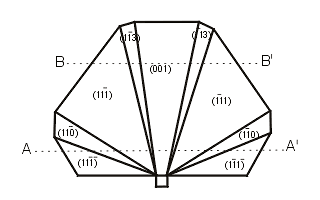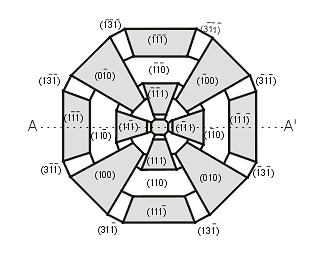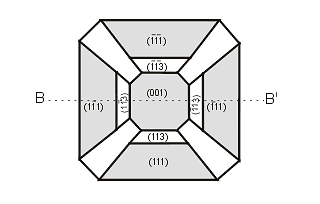|
Structure inhomogeneities (zoning, sectoring, and graining) are main diagnostic features. To examine these, a binocular microscope with a magnification factor of 40x and higher is used.
When working with such a microscope, the following illumination modes are recommended:
- dark-field illumination or backlighting;
- fiber-optic lighting.
It is also recommended to use various ways of gripping the stone in the stoneholder of the microscope.
In some cases, to find structure inhomogeneities and to study these in more detail, more complex laboratory methods, such as color cathodoluminescence, are used.
 Growth zones and color zoning in natural and synthetic diamonds
Growth zones and color zoning in natural and synthetic diamonds |
- In a natural diamond, growth zoning is usually unobservable under a microscope. Rarely, it is possible to observe a "phantom". The growth zoning is parallel to octahedron planes (the angle between two zoning directions corresponds to the angle between octahedron facets).
- Color zoning of natural diamonds is also observable in a limited number of cases. The color zoning is characterized by an uneven boundary between two regions having different color saturation. No periodic change in the color of a crystal is observed within a single growth sector.
- Unlike a natural diamond, a synthetic grows not from the center to the periphery but in all directions from the nucleus (except in the direction perpendicular to a growth container wall). The nucleus for growing a synthetic diamond is oriented so that the direction perpendicular to the growth container wall is usually [001] (sometimes - [111]).
- In synthetic diamond crystals, besides octahedral growth sectors (111), cubic ones (001) are developed. Rhombic-dodecahedronal (110) and tetragon-trioctahedral (113) growth sectors may also occur.
- During the growth of synthetic diamonds, the temperature and other parameters of the crystallization solution fluctuate. As a result, yellow, yellow-brown, and brown crystals acquire color zoning in the form of alternating layers having different color saturation. This zoning can be observed by viewing a crystal in the direction parallel to its growth layers. It is the most effective to view a cut diamond either laterally, in parallel to the girdle plane, or from the pavilion side, at different orientations of the stone.
|
 Growth sectors in natural and synthetic diamonds
Growth sectors in natural and synthetic diamonds |
|
|
 Graining in natural and synthetic diamonds
Graining in natural and synthetic diamonds |
Graining is structure inhomogeneities and various defects in a regular crystal structure, which look like turbid or "streamy" regions of a stone. These regions may be either colored or colorless.
- Graining is peculiar to both natural and synthetic diamonds.
- In natural diamonds, graining planes are usually parallel to octahedron planes (the angle between two graining directions corresponds to the angle between octahedron planes). In synthetics, graining planes are either located along the boundaries of growth sectors or form a "parallel hatch" inside the sectors.
- Patterns formed by intersecting graining planes may also serve as diagnostic features. In natural diamonds, cross-like and "tatami" patterns are sometimes observed. Octagons and sandglass-like patterns (either complete or partial) are typical for synthetic diamonds. Some other graining patterns may also occur in the synthetics.
| Light graining line in a natural polished diamond
|
|
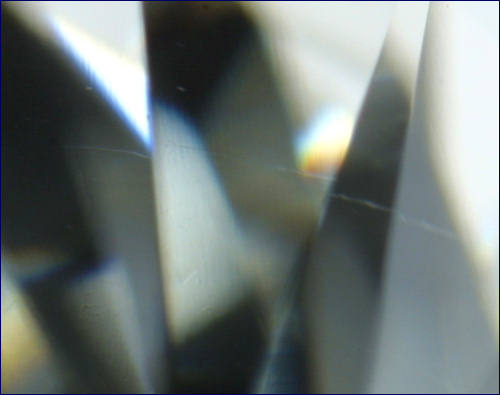 |
| Light graining line in a natural polished diamond
|
|
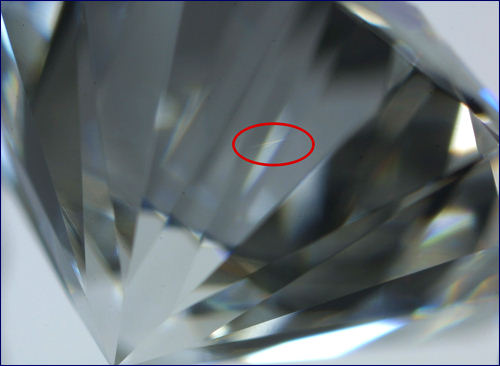 |
| Dark graining line in a natural polished diamond
|
|
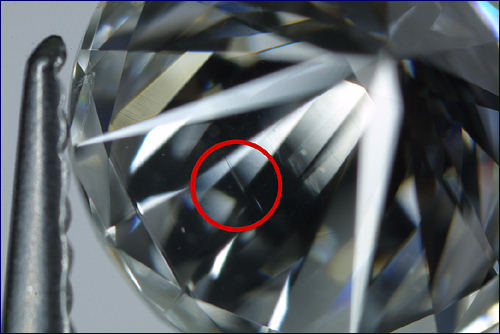 |
|
 Recommended procedure for studying structure inhomogeneities
Recommended procedure for studying structure inhomogeneities |
- Carefully clean the sample under study before starting the tests.
- Take a microscope and switch on "dark field" illumination.
- Thoroughly examine the sample under the microscope.
- During the examination, pay attention to the presence of structure inhomogeneities and their properties (color and arrangement).
- To observe the stone in more detail, use a fiber-optic light source at larger magnification.
- Identify the observed features using the description of structure inhomogeneities that occur in natural and synthetic diamonds.
|
|
